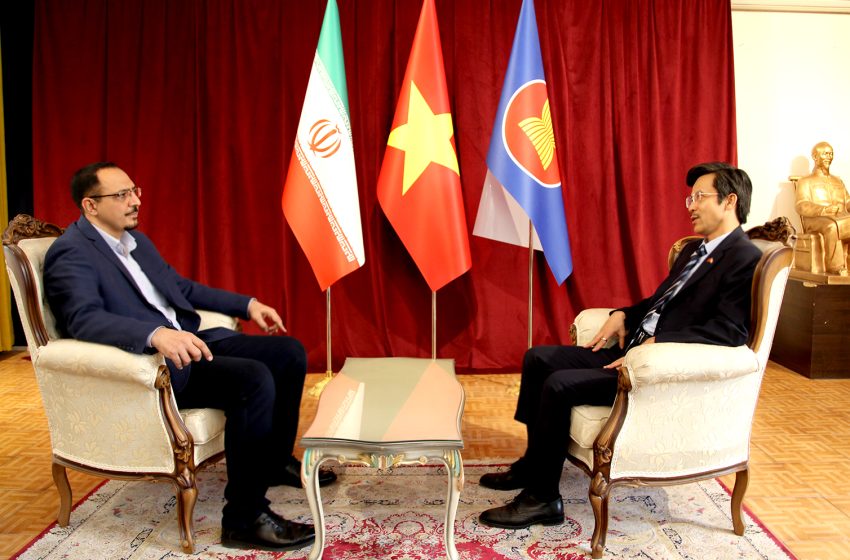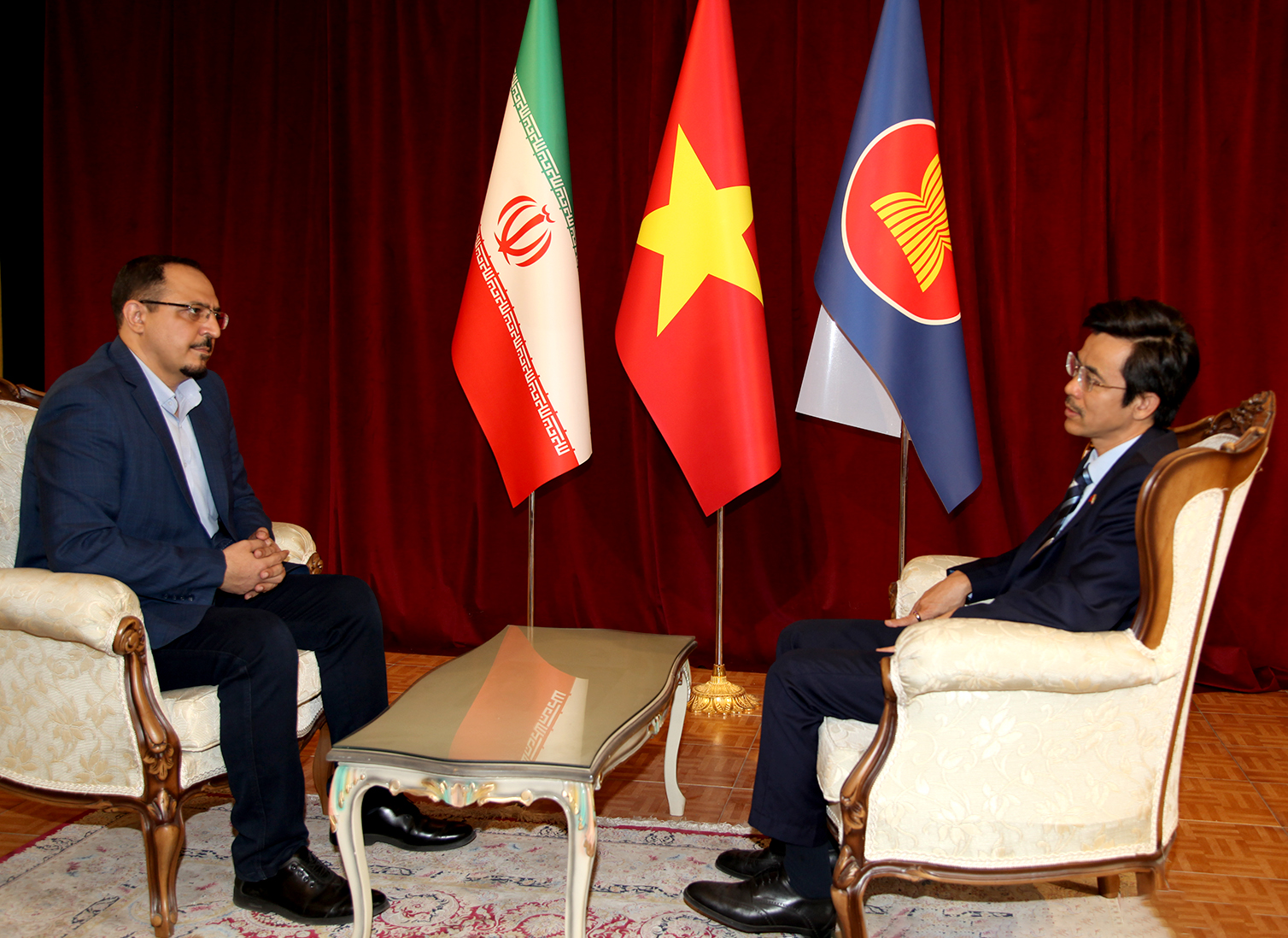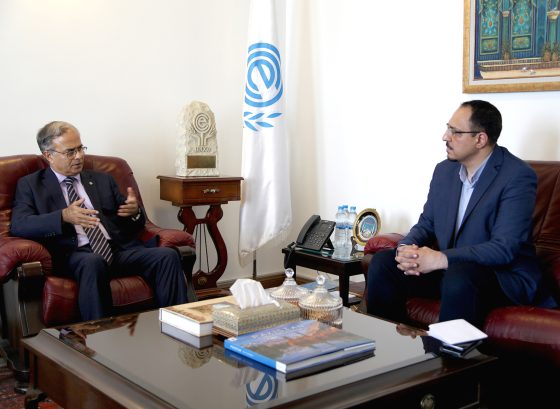“Vietnam Ready to be a Bridge between Iran and the ASEAN.” Asserts Vietnamese Ambassador to Iran

In an AVA Diplomatic exclusive interview with the Vietnamese Ambassador to Tehran, Mr. Nguyen Luong Ngoc, the prospects of strategic cooperation between the two countries were discussed comprehensively. Emphasizing Iran’s position as a key partner in West Asia, Mr. Ambassador announced his country’s readiness to serve as a bridge between Iran and the ASEAN. Highlighting Vietnam’s remarkable experience in economic development, he stressed the shared goal of both nations to reach two billion dollars in bilateral trade. This interview also addressed neglected capacities in the cultural, historical, scientific and technological fields and provides a practical roadmap for further strengthening relations between the two countries.
AVA Diplomatic’s Exclusive Interview with
Mr. Nguyen Luong Ngoc, Vietnam’s Ambassador in Iran
What postings and positions did you hold before being appointed as the Vietnamese Ambassador to Iran?
Before being appointed Ambassador to the Islamic Republic of Iran, I served in several functional departments of the Vietnamese Ministry of Foreign Affairs, including the Consular Department, the Department of International Law and Treaty. Overseas, I completed two terms at the Vietnamese Embassies in India and Australia which have given me an unforgettable experiences in my diplomatic career.
Considering the geopolitical developments in Asia and the Middle East, what is the position of Iran in Viet Nam’s foreign policy?
Iran holds a meaningful place in Việt Nam’s foreign policy as an important partner in West Asia/Middle East. Việt Nam consistently pursues a foreign policy of independence, self-reliance, diversification and multilateralization, as well as a friend, a reliable partner, and a responsible member of the international community. In this spirit, Viet Nam values Iran as a nation of ancient civilization, rich culture, and significant geopolitical importance. The two economies are complementary and possess vast potential for further cooperation. Viet Nam wishes to deepen cooperation with Iran in all fields, particularly politics, economy, culture, and people-to-people exchanges.
How can Viet Nam play a role as a mediator or strategic partner in strengthening Iran’s position in Southeast Asia and ASEAN?
As a proactive and responsible member of ASEAN, Viet Nam has demonstrated a balanced and constructive approach in regional diplomacy. Promoting this position, with lessons from the experience of a country that has gone through decades of war and a difficult but successful development process, Viet Nam can not only act as a bridge for Iran to expand relations with ASEAN but can also share our experiences in regional and international integration. Through bilateral and multilateral cooperation frameworks, we look forward to supporting Iran in promoting more substantive, deeper and broader cooperation with ASEAN member countries.
To what extent can Viet Nam’s multilateral foreign policy and strategic independence be a model for other countries?
 Simply put, Viet Nam always implements a foreign policy of diversification, multilateralization, being friends with all countries regardless of political regime, while maintaining independence, self-reliance, and peace-loving, on the basis of mutual benefit and mutual respect, for peace, stability and development in the region and the world. Regarding defense policy, Vietnam persistently implements the “Four No’s” principle: no military alliances; do not take the side of one country against another; no foreign military bases; do not use or threaten to use force in international relations.
Simply put, Viet Nam always implements a foreign policy of diversification, multilateralization, being friends with all countries regardless of political regime, while maintaining independence, self-reliance, and peace-loving, on the basis of mutual benefit and mutual respect, for peace, stability and development in the region and the world. Regarding defense policy, Vietnam persistently implements the “Four No’s” principle: no military alliances; do not take the side of one country against another; no foreign military bases; do not use or threaten to use force in international relations.
On that foundation, Vietnam has had diplomatic relations with 194 countries, has 23 strategic partners or comprehensive strategic partners (including 5 permanent members of the United Nations Security Council), and participates in more than 70 international organizations. In parallel, a balanced and constructive approach helps us deepen relations with all major countries, while protecting sovereignty and autonomy. Vietnam’s experience shows that any country can gradually build strategic autonomy, promote economic development and contribute to regional and global peace, security and development.
How has Viet Nam been able to achieve significant economic growth with the “Đổi Mới” (renovation/economic reforms) policy? Is this model also applicable to Iran?
Viet Nam’s Đổi Mới reforms, launched in 1986, set in motion a transition from a centrally planned system to a socialist-oriented market economy. Through sequenced agricultural reforms, encouragement of the private sector, and steady international integration, Viet Nam has recorded average GDP growth of about 6– 7% per year over nearly four decades, reduced poverty from roughly 60% to below 2%, and emerged as a reliable manufacturing hub. In 2024, the economy ranked 32nd globally; total trade exceeded USD 786 billion, placing Viet Nam among the world’s top 20 by trade turnover. In exports, Viet Nam ranks first worldwide in cashew nuts and pepper; second in coffee, footwear, and furniture; and third in rice and garments.
For Iran, whose young, increasingly skilled workforce and strategic location are clear strengths, Viet Nam’s experience offers a set of practical levers: continue gradual, well-sequenced reforms; empower SMEs; advance human resource development; and engage more actively in multilateral trade to unlock economic potential. At the same time, we recognize that every nation has its own history and development conditions; rather than a template, these lessons are best treated as references to be studied and adapted flexibly to Iran’s context, institutions, and priorities.
What are the biggest obstacles to trade between Iran and Viet Nam, and how can they be overcome?
 Despite clear potential, two-way trade remains modest, partly because banking and payment constraints – stemming from limited interbank connectivity – raise transaction costs and risks for firms. In parallel, transport and logistics frictions -including the absence of direct air and sea links – add time and cost; business communities have repeatedly called for direct sea routes, charter flights, and streamlined travel/visa procedures to spur commerce. Against this backdrop, I believe the private sectors of both countries should intensify market-information sharing, step up direct business connections, and continue holding bilateral business forums while expanding charter services – indeed, the first two charter flights operated in March 2025 – so that needs are identified early, partners are matched, and bottlenecks are resolved in a timely manner.
Despite clear potential, two-way trade remains modest, partly because banking and payment constraints – stemming from limited interbank connectivity – raise transaction costs and risks for firms. In parallel, transport and logistics frictions -including the absence of direct air and sea links – add time and cost; business communities have repeatedly called for direct sea routes, charter flights, and streamlined travel/visa procedures to spur commerce. Against this backdrop, I believe the private sectors of both countries should intensify market-information sharing, step up direct business connections, and continue holding bilateral business forums while expanding charter services – indeed, the first two charter flights operated in March 2025 – so that needs are identified early, partners are matched, and bottlenecks are resolved in a timely manner.
When was the last meeting of the Joint Commission on Economic Cooperation between the two countries held, and what is your assessment of the impact and position of this commission in expanding bilateral relations?
The most recent meeting of the Viet Nam–Iran Inter-Governmental (Joint Economic) Committee was the ninth session, held in Tehran on 15–16 July 2017. In recent exchanges, the two sides agreed to prepare the tenth session expected to be held in Ha Noi in the coming time. In practice, the Committee functions as the key inter-governmental mechanism for steering economic ties: it reviews implementation, addresses policy bottlenecks, such as payments and banking and sets targets and new areas of cooperation in trade, agriculture, standards and customs, and connectivity. Senior leaders of both countries have affirmed their intention to make full use of this forum to advance practical trade-facilitation measures and to monitor the implementation of signed agreements.
What was the volume and dollar value of trade exchanges between Iran and Vietnam last year, and how have these indicators changed compared to previous years?
Before 2018, Viet Nam–Iran trade generally hovered around hundreds of millions of US dollars: about US$350 million in 2015 and roughly US$352 million in 2018. However, in recent years, the figure has remained just under US$200 million (around $150 million last year). As for expectations, although current trade is modest for the reasons noted above, the two countries’ leaders have agreed on a medium-term goal of exceeding US$2 billion and have reiterated this in bilateral exchanges. This shows that, despite a modest starting point, both sides are setting an ambitious target, backed by concrete steps to gradually address bottlenecks in payment channels, transport and logistics, and business-to-business connectivity in order to realize that goal.
What are the main export and import items between the two countries?
On the composition of trade, I would note that our two economies are complementary rather than competitive. From Viet Nam, agricultural, fishery, and light-industrial products such as pepper, cashew nuts, tea, coffee, seafood, natural rubber, and footwear are already present in the Iranian market; conversely, from Iran, petrochemical products and polymer materials, fertilizers, rubber, base metals, and pharmaceuticals, alongside pistachios and dried fruits, poultry by-products (such as chicken feet), construction stone, and handicrafts, are well positioned for the Vietnamese market. These flows align with the needs of our business communities, especially as Iran’s imports of coffee have increased and Iranian industry associations are promoting imports of Vietnamese products (coffee, tea, and other promising agricultural goods) for domestic consumption and regional re-export. Building on this foundation, we can broaden cooperation along the value chain— from agriculture and processing to petrochemicals and plastics—provided this is accompanied by practical facilitation in payments, logistics, and technical standards.
Considering the history of the presence of Iranian merchants in Vietnam since the 15th century and the cultural impacts resulting from it, what solutions do you offer to revive these historical ties and strengthen cultural relations between the two countries in the current situation?
Our two peoples are linked by centuries of commerce along the Indian Ocean–South China Sea routes; in central Viet Nam, Hội An – now a UNESCO World Heritage Site – once welcomed international merchants from Persia. Building on that history, I see four mutually reinforcing directions: (i) organize two-way, annual Culture Weeks—building on Viet Nam Culture Week in Tehran (2023) and Iran Film Week in Hà Nội (April 2025) – with carefully curated programs (film screenings, calligraphy, handicrafts, music); (ii) expand language and academic linkages, including Persian courses in Hà Nội, Vietnamese language–culture courses in Tehran, and more scholarships plus lecturer/student exchanges; (iii) build tourism bridges on the basis of the charter flights that have been, and are being operated; and (iv) co-create heritage content and exhibitions. Taken together, these steps can help revive our historical ties in a modern, people-centered way, deepen mutual understanding, and open sustainable cooperation in culture, education, and tourism.
What capacities do Iran and Vietnam have for expanding scientific and educational cooperation?
 Both countries possess solid and complementary scientific foundations. On Iran’s side, as I understand, you have seen rapid growth in knowledge-based enterprises, and Iran ranks among the world’s leaders in nanotechnology research output; authorities also highlight strengths in biotechnology and stem-cell research. These capacities open practical avenues for joint laboratories, researcher exchanges, and technology transfer. On Viet Nam’s side, we are prioritizing semiconductors, artificial intelligence, and green energy under our strategy through 2030, while upgrading talent pipelines and research infrastructure – directions that align well with Iran’s nano/biotech strengths and where both sides can study and advance cooperation in the period ahead. In education and scholarships, we have already had students studying each other’s languages; this year, Viet Nam expects to send three students to Iran to pursue Persian language and culture as well as other disciplines. I hope this field will receive even greater attention from both sides in the time ahead.
Both countries possess solid and complementary scientific foundations. On Iran’s side, as I understand, you have seen rapid growth in knowledge-based enterprises, and Iran ranks among the world’s leaders in nanotechnology research output; authorities also highlight strengths in biotechnology and stem-cell research. These capacities open practical avenues for joint laboratories, researcher exchanges, and technology transfer. On Viet Nam’s side, we are prioritizing semiconductors, artificial intelligence, and green energy under our strategy through 2030, while upgrading talent pipelines and research infrastructure – directions that align well with Iran’s nano/biotech strengths and where both sides can study and advance cooperation in the period ahead. In education and scholarships, we have already had students studying each other’s languages; this year, Viet Nam expects to send three students to Iran to pursue Persian language and culture as well as other disciplines. I hope this field will receive even greater attention from both sides in the time ahead.
How many Iranian tourists visited Vietnam last year? Are there chartered flights between Iran and Vietnam?
In 2024, Viet Nam welcomed roughly 17.5 million international arrivals and is targeting 22–23 million in 2025. As for the Iranian market, it is estimated that over 5,000 visitors came to Viet Nam in 2024. As noted above, since March 2025 an Iranian airline has begun operating the two first charter flights connecting Tehran with Ho Chi Minh City with 400 Iranian, marking the start of charter operations between the two countries. Looking ahead, these charters are expected to be maintained and expanded, opening further opportunities for bilateral tourism cooperation.
What measures are being taken to enhance consular services and to facilitate communications between the two countries?
In recent years, Viet Nam’s consular and visa policies have been adjusted to better facilitate citizens and travelers. First, we have introduced a 90-day, multiple- entry e-visa for all nationalities, which simplifies procedures for visitors and businesses. Regarding the new long-term visa policy, Viet Nam has adopted a visa- exemption scheme of up to five years for certain priority categories serving socio- economic development including scholars, experts, scientists, professors, chief engineers, high-skilled digital/industrial personnel; investors and leaders of major global corporations; prominent cultural, artistic and sports figures; and honorary consuls, etc. (effective 15 August 2025).
At the Embassy, we are committed to providing clear, prompt consular procedures and services that meet applicants’ needs. To further enhance consular and visa cooperation between our two countries, we encourage closer coordination among the relevant authorities on both sides such as the Vietnamese Consular Department, the Immigration Department, and the consular sections at the embassies in each country, so that procedures are increasingly streamlined, standards harmonized, and information shared more effectively.
During the 12-Day War between Israel and Iran, what measures did the Vietnam’s Embassy in Tehran take to protect Vietnamese nationals?
We immediately activated our 24/7 citizen-protection mechanism, set up hotlines and an online registration channel, and proactively contacted Vietnamese nationals to verify each person’s safety. In parallel, the Embassy coordinated closely with Iranian authorities on security and movement guidance; worked with the foreign ministries and the consular sections at the embassies of Iran’s neighboring countries to facilitate evacuation and transit for those wishing to depart; and dispatched officers to key border checkpoints and airports to assist with exit procedures and onward travel to third countries. Where necessary, we arranged temporary accommodation, provided essential supplies, and helped arrange, and where needed, cover the cost of air tickets home. Throughout, the Embassy issued regular advisories, assisted with ticket changes/rebookings, and maintained round- the-clock communications so that our citizens received timely, practical support.
In September 2025, Viet Nam proudly celebrates 80 years of independence. Our journey from devastation to dynamic growth demonstrates the power of self- reliance, reform, and peace. We remain committed to being a trustworthy partner and responsible member of the international community, and we look forward to elevating Viet Nam–Iran relations, unlocking economic potential, and contributing to a peaceful, prosperous future for our peoples.




